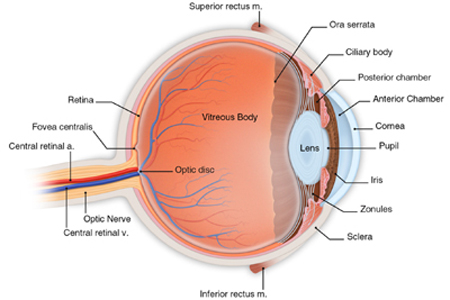1. What Is a Cataract?
You might recognize cataracts if you’ve seen older people or animals with eyes that appear cloudy. Cataracts are typically related to the natural aging process and found in older people. Often they gradually progress over time, beginning in our 40s and 50s and worsening over the decades. Most cataracts will start to cause vision problems sometime after the age of 60. These are known as age-related cataracts.
Cataracts can occur in one or both eyes. As they develop independently, cataracts cannot spread from one eye to the other. 2. Are There Other Types of Cataracts Besides Age-Related Cataracts?
There are several other types of cataracts, which are important to know, including:
Understanding other conditions, incidences, and exposures that can lead to cataracts and awareness of cataracts in newborns, infants, and young children is important for awareness, early detection, and proper monitoring and treatment. 3. How Do Cataracts Affect Vision?
As cataracts progress, they cause vision to become increasingly dull or blurry and seeing to become more difficult. Further, a cataract can cause the lens the normally clear lens to become yellowish or brownish with aging, which can cause vision to gradually acquire a yellowish or brownish shade or tint.
Most people will not notice vision changes due to cataracts early on in their development. As cataracts progress, vision changes will become more and more noticeable and may become problematic, interfering with normal, everyday activities. In our next blog post in this series, we’ll talk about when it’s time to consider cataract treatment (surgery). 4. What Are the Symptoms of Cataract?
Most commonly, people with cataracts experience one or more of the following:
Many of these symptoms are not unique to cataracts. If you have any of these symptoms, please contact us immediately. While cataracts are not an eye emergency, these symptoms may be signs of a more serious eye condition and should be checked by an eye doctor. 5. How Is a Cataract Detected?
Cataracts are detected through a complete eye exam, including:
6. Who Is at Risk for a Cataract?
Earlier we addressed a number of risk factors for developing cataracts, including:
In addition to these risks, the following increase the risk of developing cataracts:
Generally, protecting your health and your eyes goes hand-in-hand. Living a healthy lifestyle can minimize your risk of developing cataracts and other vision threatening conditions. 7. How Common Are Cataracts?
Cataracts are the leading cause of vision loss and blindness in the United States and affect more than 24 million Americans aged 40 and older. According to the American Academy of Ophthalmology (AAO), approximately half of all Americans have cataracts by the age of 75. And according to the National Eye Institute (NEI), by the time Americans reach 80, more than half will either have a cataract or have had cataract surgery.
8. How Are Cataracts Treated?
While cataracts can only be treated surgically, the symptoms of early cataracts may be improved with conservative treatment. New prescriptions, brighter lighting, anti-glare sunglasses, and magnifying lenses can be used to improve vision early in the development of cataracts. Once cataracts are advanced, the only option is surgical removal.
With more than 3 million cataract surgeries preformed each year in the United States and more than 20 million each year worldwide, cataract surgery is one of the most common surgical procedures. Recent advances in cataract surgery have allowed for smaller incisions and improved outcomes. Thankfully, the AAO states, “The success rate of cataract surgery is excellent. Improved vision is achieved in the majority of patients if other vision-limiting problems are not present.” As cataracts are so prevalent and cataract surgery is so common, we’ll dedicate the rest of our blog posts in this Cataract Awareness Month series to surgery to these related subjects:
Learn More about Cataracts
Watch this series of short video clips to learn more about cataracts, symptoms, and treatment:
Have Symptoms of or Risk Factors Associated with Cataracts?
If you or a loved one has any of the symptoms described above or would like to discuss your risk of developing cataracts, please call us today to schedule an appointment.
Comments are closed.
|
EYE HEALTH BLOGCategories
All
Archives
July 2024
|
|
Kadrmas Eye Care New England
55 Commerce Way, Plymouth, MA 02360
14 Tobey Road, Wareham, MA 02571 133 Falmouth Road (Rt 28), Mashpee, MA 02649 |
Phone Number:
1-508-746-8600 Hours: Monday through Friday — 8 AM – 4:30 PM |



 RSS Feed
RSS Feed
